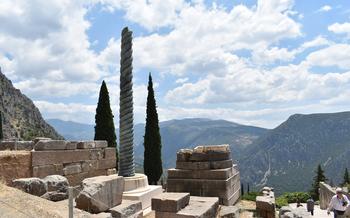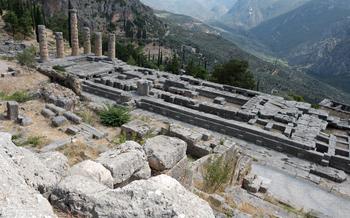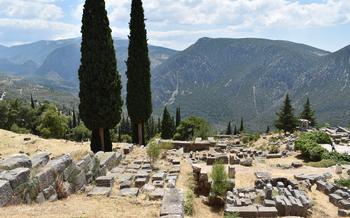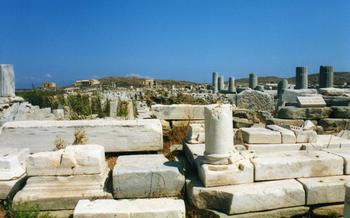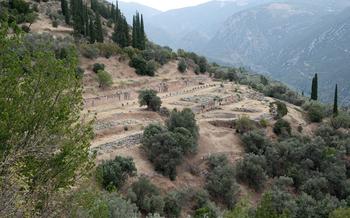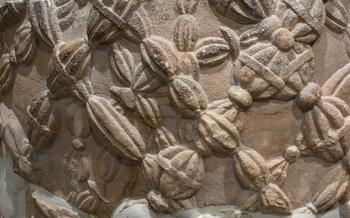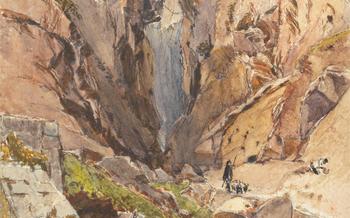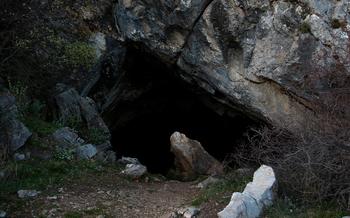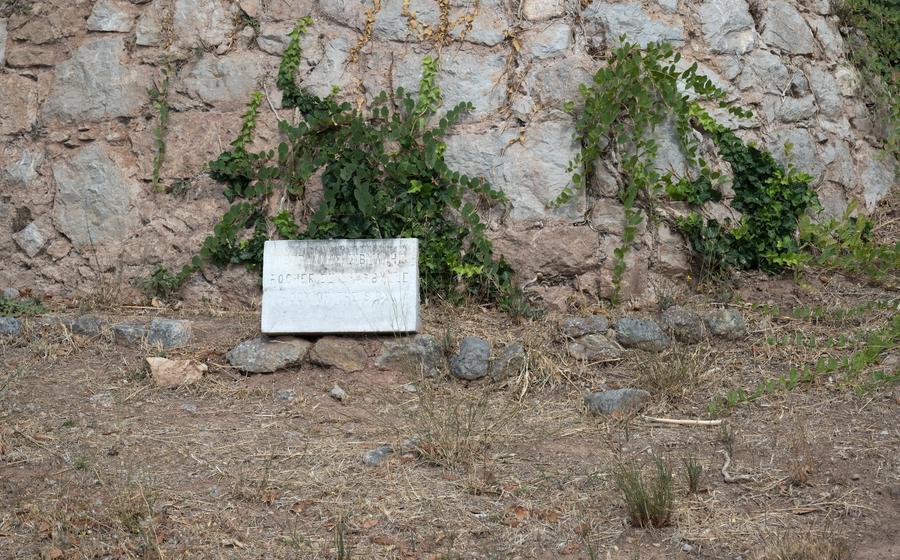
The Sibyl Rock
- Delphi: The Heart of Antiquity
- The Sibyl: Unveiling the Enigma
- The Location of the Sibyl Rock
- Unveiling the Rock: Physical Description
- The Rock's Connection to Prophecy
- Ancient Rituals and Ceremonies at the Sibyl Rock
- The Sibyl's Prophecies: Past and Present
- Ancient Inscriptions and Markings
- The Sibyl and the Classical World
- The Rock as a Place of Pilgrimage
- Exploring the Rock: A Visitor's Guide
- Combining History and Nature
- The Sibyl Rock as a Symbol of Wisdom
- Insider Tip: The Path of the Oracle
Delphi: The Heart of Antiquity
Delphi, nestled in the scenic valley of Phocis, has long been revered as a sacred site since ancient times. Its name, derived from the Greek word 'delphis,' meaning womb, alludes to its profound significance as the birthplace of Apollo and the epicenter of his oracle. This ancient sanctuary, believed to be the center of the world, attracted pilgrims, seekers of knowledge, and dignitaries from across the Hellenic world, who sought guidance and prophecies from the Oracle of Delphi. As one of the most important religious and political centers in ancient Greece, Delphi played a pivotal role in shaping the course of history, mythology, and culture.
The Sibyl: Unveiling the Enigma
In the annals of Greek mythology, the Sibyl stands as an enigmatic and revered figure, shrouded in mystery and imbued with the power of prophecy. According to legend, the Sibyl was a priestess of Apollo, the god of prophecy and music, chosen to deliver his divine messages to mortals. Her utterances, often cryptic and ambiguous, were sought after by kings, statesmen, and ordinary citizens alike, who sought guidance and insight into the future.
The Sibyl's prophetic abilities were believed to stem from her unique connection to the divine realm. It was said that Apollo had breathed into her mouth, bestowing upon her the gift of foresight. Her prophecies, delivered in a trance-like state, were considered sacred and were recorded in a collection known as the Sibylline Books. These books were safeguarded by the priests of Apollo and consulted only in times of great need or crisis.
The Sibyl's enigmatic nature and the awe-inspiring power of her prophecies have captivated the human imagination for centuries. Her legacy extends beyond the realm of ancient Greece, influencing literature, art, and popular culture to this day.
The Location of the Sibyl Rock
The Sibyl Rock is situated within the Delphi Archaeological Site, a sprawling complex of ancient ruins and monuments. It is nestled close to the Castalian Spring, a sacred spring that was believed to possess oracular powers. The spring was considered a source of inspiration and purification for those seeking guidance from the oracle. The Sibyl's Rock is thus embedded within a sacred topography, surrounded by other significant landmarks and structures that contribute to the site's rich historical and mythological significance.
Unveiling the Rock: Physical Description
The Sibyl Rock stands as an imposing rock formation, commanding attention with its sheer size and distinct features. Its geological composition reveals a fascinating interplay of natural forces, with layers of sedimentary rock telling the story of millions of years. The rock's surface bears the marks of time and the elements, shaped by weathering and erosion into intriguing patterns and crevices. Despite its weathered exterior, the rock's inherent strength and resilience remain evident, hinting at its enduring significance throughout history.
The Rock's Connection to Prophecy
The Sibyl Rock possesses an intrinsic link to prophecy, deeply rooted in ancient beliefs and superstitions. According to mythology, it was here that the Sibyl sat, uttering her cryptic prophecies that reverberated throughout the ancient world. The rock served as her sacred seat, a place of profound connection to the divine.
In ancient times, people believed that the rock was imbued with a mysterious power that allowed the Sibyl to receive messages from the gods. They believed that the rock acted as a conduit between the realms of the mortal and the divine, enabling the Sibyl to tap into the knowledge of the future.
The Sibyl's prophecies were highly revered and sought after by kings, statesmen, and ordinary people alike. They were believed to hold the power to influence the course of events, warn of impending disasters, and guide people towards a better future. The Sibyl's utterances were often ambiguous and open to interpretation, adding to their mystique and compelling people to seek her wisdom.
Ancient Rituals and Ceremonies at the Sibyl Rock
The Sibyl Rock held a prominent place in ancient religious practices and rituals. Before seeking prophetic utterances, individuals and delegations would undergo purification rites to cleanse themselves both physically and spiritually. These rituals often included bathing in the nearby Castalian Spring, believed to possess sacred and purifying properties.
Offerings and sacrifices were made to the Sibyl and the gods associated with her, such as Apollo and Artemis. These offerings could range from animals to precious objects, reflecting the reverence and gratitude of those seeking guidance and predictions.
Invocation of the Sibyl was a crucial part of the rituals. Ancient sources describe how the priestess would enter a trance-like state, believed to be inspired by the divine presence. Through this trance, she would deliver her prophecies, often in cryptic and enigmatic language, which required interpretation by skilled seers.
The Sibyl Rock and the rituals associated with it served as a bridge between the mortal and divine realms. It was a place where people sought answers to their questions, guidance for their decisions, and a glimpse into the mysteries of the future.
The Sibyl's Prophecies: Past and Present
The Sibyl of Delphi, known for her prophetic powers, left a profound impact on ancient history and culture. Her prophecies, uttered in a frenzied state of trance, were highly revered and deeply ingrained in the fabric of Greek society.
Historical Accounts
Ancient writers, such as Plutarch and Diodorus Siculus, meticulously recorded the Sibyl's prophecies. These prophecies covered a wide range of topics, including political upheavals, natural disasters, and the rise and fall of civilizations. One of her most famous prophecies predicted the Trojan War, which served as a cautionary tale about the dangers of hubris and the wrath of the gods.
Contemporary Interpretations
In modern times, scholars continue to study the Sibyl's prophecies, seeking to understand their significance and relevance to contemporary society. Some interpret them as allegorical representations of moral and ethical principles, while others view them as glimpses into the collective unconscious or as expressions of a deeper spiritual reality.
Relevance to Modern Life
While the Sibyl's prophecies were primarily intended for the ancient Greeks, their messages still resonate with people today. They remind us of the importance of humility, the interconnectedness of all things, and the power of self-knowledge. By delving into these ancient prophecies, we can gain insights into our own lives and find guidance in navigating the complexities of the modern world.
Ancient Inscriptions and Markings
The Sibyl Rock bears witness to the deep reverence and awe that ancient Greeks held for the Sibyl and her prophecies. Throughout the centuries, visitors and pilgrims left their mark on the rock, etching messages, dedications, and symbols that offer a glimpse into the beliefs and practices of the time.
Archaeologists have discovered numerous inscriptions and markings on the Sibyl Rock, providing valuable insights into the significance of the site and its connection to the Oracle of Delphi. These inscriptions range from simple names and dates to elaborate dedications and prayers addressed to the Sibyl.
Some of the most intriguing inscriptions include:
- Dedications to the Sibyl, expressing gratitude for her guidance and wisdom.
- Invocations to the Sibyl, seeking her favor and protection.
- Prophecies and predictions, believed to be inspired by the Sibyl's divine powers.
- Personal messages and reflections, left by pilgrims who sought guidance and solace at the Sibyl Rock.
These inscriptions not only provide a tangible link to the past but also offer a glimpse into the minds and hearts of those who sought wisdom and guidance from the Oracle of Delphi. They serve as a reminder of the enduring power of prophecy and the enduring legacy of the Sibyl Rock.
The Sibyl and the Classical World
The Sibyl of Delphi had a profound impact on the intellectual and cultural landscape of the classical world. Her prophecies and teachings resonated far beyond the confines of Delphi, shaping the beliefs, literature, and art of ancient Greece and beyond.
In literature, the Sibyl was a recurring figure, often depicted as a wise and enigmatic prophetess. Her prophecies were frequently referenced in works of poetry, drama, and philosophy, inspiring countless writers and thinkers. One of the most famous examples is Sophocles' play "Oedipus Rex", where the Sibyl's prophecies play a pivotal role in the tragic downfall of the protagonist.
In art, the Sibyl was a popular subject for depictions in paintings, sculptures, and mosaics. Often portrayed as an elderly woman with a stern expression and flowing robes, she was frequently depicted in scenes of prophecy or contemplation. Notable examples include the "Sibyl of Cumae" painting by Michelangelo and the "Sibyl of Delphi" mosaic from the Villa of Hadrian in Tivoli, Italy.
The Sibyl's influence extended beyond Greece, reaching into the Roman Empire and beyond. In Rome, the Sibylline Books, a collection of prophecies attributed to the Sibyl, were consulted by the Roman Senate in times of crisis. The books were considered sacred and were kept under strict guard in the Temple of Jupiter Optimus Maximus on the Capitoline Hill.
The Sibyl of Delphi remains an enduring figure in the annals of history. Her prophecies and teachings continue to intrigue and inspire people to this day, serving as a reminder of the timeless power of wisdom, prophecy, and the human spirit.
The Rock as a Place of Pilgrimage
In ancient Greece, the Sibyl Rock held a profound significance as a place of pilgrimage. People from all corners of the Hellenic world journeyed to Delphi, seeking guidance, predictions, and a glimpse into the divine. The rock was believed to be a gateway to the realm of the gods, where mortals could communicate with the supernatural and seek answers to life's most pressing questions.
Pilgrims would arrive in Delphi with offerings and sacrifices, eager to receive the Sibyl's prophecies. They would undergo purification rites in the nearby Castalian Spring, shedding their impurities before approaching the sacred rock. As they stood before the Sibyl, they would present their offerings and ask their questions, hoping to gain insights into their destiny and the future.
The Sibyl's prophecies were highly revered and sought after. People believed that her words carried the weight of divine authority and could influence the course of their lives. They would often return to Delphi multiple times, seeking guidance on matters of war, politics, personal relationships, and other important decisions.
Even today, the Sibyl Rock continues to attract visitors from around the world who are drawn to its mystical aura and the allure of ancient prophecies. While the Sibyl's voice is no longer heard, the rock remains a potent symbol of the spiritual and religious significance that Delphi held in the ancient world.
Exploring the Rock: A Visitor's Guide
To reach the Sibyl Rock, visitors can follow a well-marked path that leads from the main archaeological site. The walk takes about 15-20 minutes and offers stunning views of the surrounding landscape. It's recommended to visit the rock during the early morning or late afternoon to avoid the harsh midday sun. For photography enthusiasts, the golden light of these hours is ideal for capturing the rock's grandeur and the surrounding scenery.
Combining History and Nature
The Sibyl Rock is not just a historical site but also a place of breathtaking natural beauty. Surrounded by lush greenery and towering mountains, it offers stunning views that will leave you in awe. The Archaeological Site of Delphi is set against a backdrop of dramatic cliffs and deep gorges, creating a landscape that is as awe-inspiring as it is serene.
Take advantage of the numerous hiking trails that wind through the surrounding area, allowing you to explore the natural wonders of Delphi at your own pace. Whether you prefer a leisurely stroll or a more challenging hike, there are trails suitable for all fitness levels. As you walk, keep an eye out for the diverse flora and fauna that call this region home.
Combine your historical exploration with a refreshing dip in the Castalian Spring, located just a short distance from the Sibyl Rock. According to ancient legend, the spring's waters had the power to purify and inspire those who drank from them. Immerse yourself in the refreshing waters and feel a sense of rejuvenation as you connect with the ancient rituals that once took place here.
The Sibyl Rock as a Symbol of Wisdom
The Sibyl Rock stands as a potent symbol of wisdom, inviting visitors to contemplate the profound lessons of the past and forge a deeper connection with their inner knowledge. This ancient site whispers secrets of self-reflection and growth, encouraging individuals to embrace their own intuitive powers. By immersing oneself in the energy of the rock, one can gain valuable insights into the mysteries of life and uncover the wisdom that lies dormant within. The Sibyl Rock serves as a reminder that true wisdom is not merely an accumulation of information, but a transformative journey of self-discovery and enlightenment.
Insider Tip: The Path of the Oracle
For an immersive experience, follow the ancient path taken by pilgrims seeking guidance from the Oracle. Begin at the Sanctuary of Apollo, passing through the sacred precinct with its well-preserved ruins. Ascend the Via Sacra, the sacred way, lined with ancient monuments. This path leads directly to the Sibyl Rock, where the oracle once uttered her cryptic prophecies. Take a moment to sit on the rock, absorbing the energy and wisdom of this sacred site. Stand where ancient seekers stood, gazing out at the stunning landscape that inspired prophecies and shaped the course of history.
